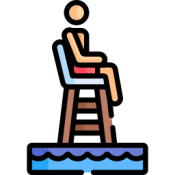Summer is here in full force. Hot weather and water—what a perfect combo! But a perfect day can turn not so perfect in an instant.
In BC each year, an average of 75 people die from drowning. Men aged 20 to 34-years-old and kids under 5 are at high risk of drowning. Surprisingly, drownings can happen quickly and quietly, unlike what we see on TV and in the movies.
As we’re getting ready for a fun day by the lake, beach, or even at home, here are some reminders on how you can prevent drowning and heat exhaustion.
Drowning Prevention

- Lifejacket vs. PFD: Lifejackets will turn you over on to your back even if you are unconscious. PFDs are lighter and less bulky, but they are only approved for recreational use and the automatic inflatable PFDs are only for persons over the age of 16 years.


- Actively supervise kids at all times in or around water. Young children or weak swimmers should be within an arms-length of caregivers; provide “touch supervision.”
- Very small kids can drown in as little as 2.5 cm (1 inch) of water. Remember to drain wading pools and empty containers of water after use.
Don’t drink: Refrain from using alcohol before or during swimming or boating activities. Save the alcohol for when you’re docked.
Preventing Heat Exhaustion
Remember the S’s: Always remember to wear sunscreen, sun hats, and sunglasses. Sunscreen should be 50 SPF or greater and should be re-applied frequently, especially if you’re going in the water.


Eat “cooling” foods and drinks: Raw veggies and fruits can hydrate and cool you at the same time – cucumber slices, watermelon. Make homemade popsicles. And of course, remember to drink water regularly before you feel thirsty.
Stay inside sometime: If you do go out in the sun, plan to be outside during the cooler parts of the day. Around 5 PM is when it’s the hottest.

- BC Coroners Service. Accidental Drowning Deaths 2008-2018. Published September 17, 2021. Available https://www2.gov.bc.ca/assets/gov/birth-adoption-death-marriage-and-divorce/deaths/coroners-service/statistical/accidental-drowning.pdf
- BC Children’s Hospital. Don’t sweat it – Keep cool this summer. June 24, 2022. Available http://www.bcchildrens.ca/about/news-stories/stories/don%E2%80%99t-sweat-it-%E2%80%93-keep-cool-this-summer
- Lifesaving Society. BC 2020 Drowning Report. Available from: https://www.lifesaving.ca/cmsUploads/lifesaving/File/Lifesaving_Drowning-2020_BC_En_.pdf
- BCCDC. Preparing for dangerous heat. July 28, 2021. Available http://www.bccdc.ca/about/news-stories/stories/2021/preparing-for-dangerous-heat
- BC Government. Be Prepared for Extreme Heat. Available from: https://www2.gov.bc.ca/gov/content/safety/emergency-management/preparedbc/know-your-hazards/severe-weather/extreme-heat
Icons from Freepik | Flaticon.com

